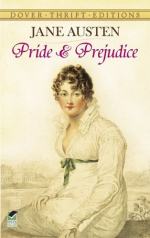|
This section contains 2,578 words (approx. 9 pages at 300 words per page) |

|
Conventions of Marriage in Pride and Prejudice
Summary: The main subject of Pride and Prejudice is marriage in an acquisitive society. The plot of the novel is driven by its examination and satire of the difficulties to be faced by any eligible female in pursuit of a husband. Austen mainly concentrates on the relationship of Elizabeth and Darcy, keeping the relationships of Jane and Bingley, Charlotte and Collins, and Wickham and Lydia in the background.
Jane Austen uses the relationships of the characters in Pride and Prejudice to accurately satirize the convention of marriage. To contradict the conventional ideals and beliefs of society, she concentrates attention on a number of important courtships, which in turn provide a backdrop to the central romance between Elizabeth and Mr. Darcy. The relationship of Mr. Collins and Charlotte Lucas; Lydia's scandalous and disgraceful elopement with Mr. Wickham; and finally Jane and Bingley's timid associations all help to further show how Austen satirizes the convention of marriage.
In Jane Austen's time, courtship was a central and absolutely necessary convention. Family and marriage created a public and central position in the social and economic measures of English society. In this novel, marriage is seen as an institution that both determines and is determined by history. (Novels for Students, 303). It was involved with the social continuation of the family line...
|
This section contains 2,578 words (approx. 9 pages at 300 words per page) |

|


